Winter is the ideal season to review your fleet of agricultural vehicles, to check on mechanical aspects of course, for preventive maintenance purposes, but also to check all your agricultural tyres. It’s worth knowing that a large number of breakdowns at the beginning of the season tend to be linked to an earlier problem that you could detect beforehand with a simple check-up. This often means that you can avoid breakdowns and save money.
Checking the level of wear or inspecting your tyres to identify irregularities will save you time when you really need it and make sure you are ready to start the new season with peace of mind.
Here is a tyre check-up that you can conduct rapidly:
1. What should you look for during an agricultural tyre check-up?
Most breakdowns are the result of problems that are carried from one season to the next, such as driving with too much load which has damaged the tyres’ sidewalls, impacts or a small hernia….
A check-up allows you to avoid a major problem during a future campaign. It is so simple to conduct a visual inspection of your tractor tyres that it would be a shame not do at least this much during the winter season.
You should pay particular attention to the following:
Signs of impacts or cuts
During your inspection, look very closely at the tread, the sidewalls and if necessary the casing of your tyre to see if there are any traces of impacts or cuts.
These signs of wear are relatively normal, above all if you work on rough terrain (presence of silex for example) or on a mixed polycropping/livestock farm. Any slight cuts or flaking on the lugs are not really a problem and won’t prevent you from using your tyre until it is completely worn, if you take care with frequent use on very abrasive ground.
On the other hand, deeper cuts or a small hernia should catch your attention, because the tyre casing may be damaged, with a high risk of the casing components causing an explosion when the load and inflation pressure are increased during the next season. In this case, an internal check-up on the casing would be wise, because the size of the outside nick does not necessarily reflect the internal damage to the structure of the tyre.
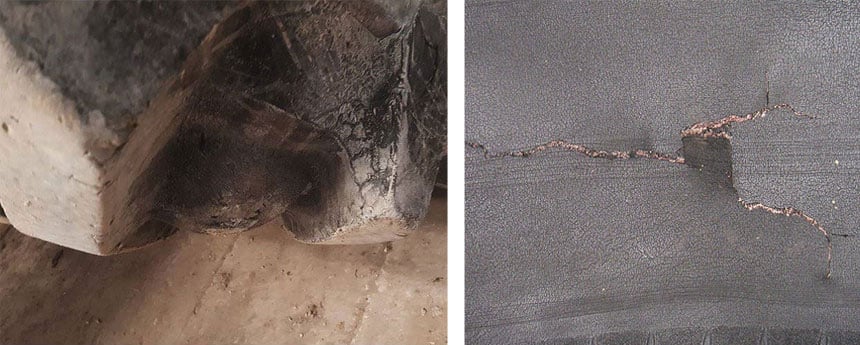 A hernia often corresponds to a break in the internal structure of the tyre
A hernia often corresponds to a break in the internal structure of the tyre
Abnormal or irregular wear to the lugs
When you observe more pronounced wear to the front, rear or side of the lugs, this is often the sign of a recurrent problem for which there could be various causes.
It could be due to:
- geometry error,
- underinflated tyres on the road
- with heavy loads, or insufficient inflation pressure when you take to the road after having worked at low pressure in the fields to avoid soil compaction.
If you notice this type of wear, you will need to make a few adjustments or additional tests to extend your tyre’s lifespan.
Check the height of the lug for irregular wear
You must check agricultural tyre wear on a regular basis. Checking the height of the studs (lugs) on the tread should suffice. Find out what the lug height was when the tyre was new and bear in mind that when it is 50% worn, your tyre begins to be less efficient in transmitting tractive force, which reduces your productivity.
You can either sell it on the second hand market and get a reasonable price, or continue to use it until it is critically worn. We consider that a tyre is worn when the height of the lugs reaches 15 mm for work in the fields and up to 10 mm for use on the road.
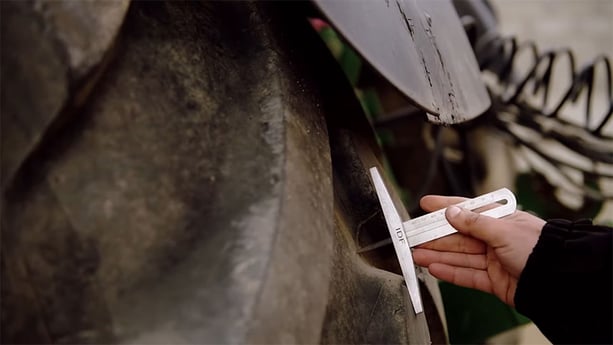 Checking wear with a lug depth gauge
Checking wear with a lug depth gauge
Analysis of behaviour on the road (vibration, road handling)
When you drive in the fields or on the road, watch out for abnormal vibrations or poor road handling, which could be a sign of misalignment. This can accelerate wear and lead to a premature replacement of your tractor tyres, so it’s best to fix the problem rapidly.
2. My agricultural tyres seem to be in good condition; minimum maintenance should therefore be carried out
If you conclude from your visual inspection that your tractor tyres are in good condition, there is no need for additional verifications. Nonetheless, don’t forget to make some regular adjustments to ensure they last longer, by following the advice below:
Inflation pressure control
Adjusting inflation pressure is an operation that should be carried out regularly, whether you use standard or IF/VF technology tyres, even though the latter have a greater tolerance with respect to the pressure used.
Depending on whether you work in the fields or in the farm’s courtyard, with or without a load, at slow or high speed, inflation pressure is never the same and it will be necessary to adapt it to preserve the lifespan of your tyres.
- If you drive a lot on the road but your tyres are often underinflated, they will flatten out on the ground, provoking abnormal wear to the lugs and shoulders as well as exerting considerable strain at the level of the rim-bead connection. Your tyres will wear more rapidly and lose around 25% of their lifespan. Pressure that is too low can cause the rubber components and tyre structure elements to overheat which can result in the tyre bursting.
- If you opt for pressure that is too high in the fields, you are also likely to damage your tyres rapidly. On soft or wet ground, an overinflated tyre leads to an increase in rolling resistance, resulting in a high slip ratio. This causes the lugs to wear rapidly.
Check the load distribution regularly
When you transport heavy loads, you must take the necessary care to balance out your trailer:
- Always follow the load index recommended by the manufacturer. By exceeding the maximum load authorised by the manufacturer, you run the risk of causing premature damage to the tyre casing.
- Reduce speed on the road: driving fast on asphalt while transporting heavy loads makes severe demands on the tread, causing overheating and damage to the rubber. So limit your speed as much as possible.
Check your alignment regularly
A mechanical defect can cause abnormal wear to your agricultural tyre.
When this wear is concentrated on a single side of the tyre, possibly with a right/left symmetry, this could be due to misalignment or a problem with camber (an off-vertical tilt in the wheels).
To extend your tyres’ lifespan, take the time to check wheel alignment, the front differential, the wear or play in the steering ball joints.
3. There are signs of abnormal wear on my agricultural tyres
Certain signs of wear may have no direct effect on the state of your tyres. Others must draw your attention and encourage you to consider replacing them.
Before you make any decision, you must identify the origin of the problem in order to find a suitable solution. Is the problem due to a mechanical fault, the wrong pressure setting, external elements (stones, sharp rocks, metallic object, etc.), unsuitable driving on the road, etc?
Once the problem has been identified, try and find the right solutions to make your tyres last longer. Here are a few possibilities with the appropriate solutions:
Problem with parallelism: carry out a rapid control
A problem with parallelism is often a cause for rapid wear. Parallelism corresponds to the left/right alignment of the wheels relative to each other.
Ideally your tyres should be perfectly parallel to the agricultural vehicle’s centerline. But due to mechanical strain when four wheel drive is engaged, work hazards, ruts or rugged terrain, your alignment settings can shift frequently, which is why it’s important to carry out a regular check-up, in particular on your front axle.
There are two types of problem with parallelism:
- Toe-in: this occurs when the front of the tyres point inwards compared to the tractor’s centreline, causing the tyre to wear on the outside.
- Toe-out: this is when the front of the tyres point outwards compared to the tractor’s centreline, causing more pronounced wear on the inside of the tyres.
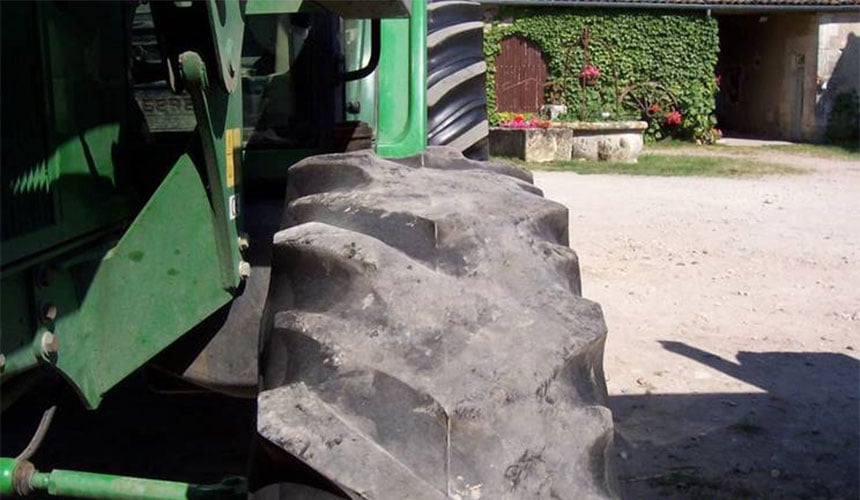 Tyre wear linked to misalignment
Tyre wear linked to misalignment
Wear due to sloping roads:
swapping over front tyres
The sloping road that you take regularly to get to your fields can cause wear to your tractor tyres, which tends to be the case when the wear is localised on the inside of the left tyre and on the outside of the right tyre.
Insufficient inflation pressure can accentuate this deterioration, but you can correct the problem by swapping over your tyres to extend their lifespan.
Perforation or cut to the tread:
hot or cold repairs?
If there is a cut or large perforation caused by a foreign body (metal, root, broken glass…) at the level of the tread or the upper part of the tyre sidewalls, you can have hot repairs carried out by a professional.
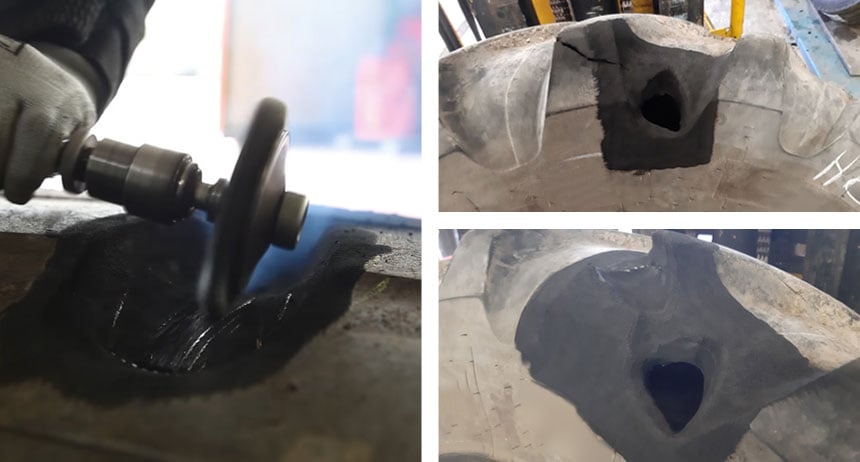 Hot repairs for a perforated tyre
Hot repairs for a perforated tyre
On the other hand, cold repairs are ideal for simple punctures, whether with an inner liner or tubeless tyre. However, cold repairs are not suitable for cuts on the tread or on the sidewalls, due to the repeated flexion and deflexion in these zones.
Rusty or distorted rim:
check tyre/rim airtightness
A rusty or distorted rim caused by intensive use can damage the tyre bead. Check all round the circumference of the rim very carefully to ensure that it is clean and that there is no trace of impact.
If there are foreign particles present, they must be cleaned to avoid any loss of airtightness during tyre flexion or deflexion at the beginning of the next season.
4. My agricultural tyres have to be replaced, why not think ahead?
Thinking ahead could mean that you avoid placing your order at the same time as all the other farmers, when demand is at its highest, towards the end of March, a period when there are often stock shortages.
A large number of farmers effectively run into problems at the same time, when their activities resume intensively, because the minor problems from the preceding period cause major problems with changes in inflation pressure or the frequent flexion or deflexion linked to the tyres’ work.
If you think that your agricultural tyres need to be replaced, why not think ahead and place your order during the quiet period, programming a delivery date that suits you, leaving the tyre dealers time to prepare your order which will be reserved in advance, and guaranteeing that you receive delivery before everyone else. It won’t cost you any more and you’ll have the right products at the right time.
For more information on tractor tyres
With Firestone, you have the guarantee of tractor tyres that deliver a real advantage, and that in choosing our brand, you can work worry-free.
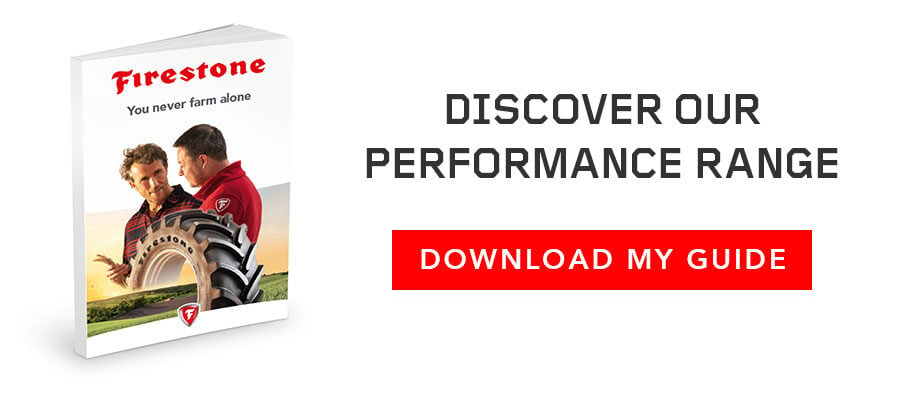
Most people who read this article have also read some of the following articles:
This information is intended only to make you aware of the technical and functional aspects of agricultural tires and their use. It does not allow you to make a judgment or a definitive conclusion on a given problem. Only your agricultural tire expert is able to make a technical assessment and take a final decision, case by case.